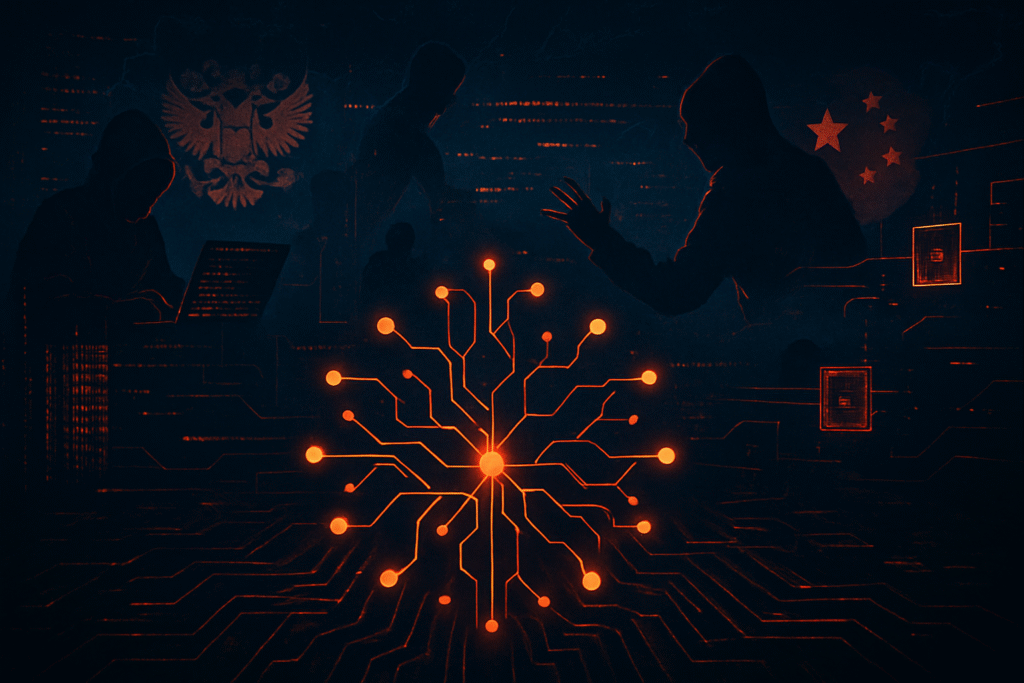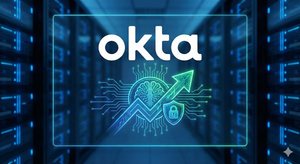Financial News
The AI Cyber War: Microsoft Warns of Escalating State-Sponsored Threats from Russia and China

The global cybersecurity landscape has entered a new and perilous era, characterized by the dramatic escalation of artificial intelligence (AI) in cyberattacks orchestrated by state-sponsored actors, particularly from Russia and China. Microsoft (NASDAQ: MSFT) has issued urgent warnings, highlighting AI's role as a "force multiplier" for adversaries, enabling unprecedented levels of sophistication, scale, and evasion in digital warfare. This development, rapidly unfolding throughout 2025, signals a critical juncture for national security, demanding immediate and robust defensive measures.
According to Microsoft's annual Digital Threats Report, released in October 2025, state-sponsored groups from Russia, China, Iran, and North Korea have significantly ramped up their adoption of AI for online deception and cyberattacks against the United States and its allies. In July 2025 alone, Microsoft identified over 200 instances of foreign adversaries using AI to create fake content online—a staggering figure that more than doubles the number from July 2024 and represents a tenfold increase compared to 2023. This rapid integration of AI underscores a fundamental shift, where AI is no longer a futuristic concept but a present-day weapon enhancing malicious operations.
The Technical Edge: How AI Redefines Cyber Offensive Capabilities
The integration of AI marks a significant departure from traditional cyberattack methodologies, granting state-sponsored actors advanced technical capabilities across the entire attack lifecycle.
Large Language Models (LLMs) are at the forefront of this evolution, enhancing reconnaissance, social engineering, and vulnerability research. Actors like Russia's Forest Blizzard are leveraging LLMs to gather intelligence on sensitive technologies, while North Korea's Emerald Sleet utilizes them to identify experts and security flaws. LLMs facilitate the creation of hyper-personalized, grammatically flawless, and contextually relevant phishing emails and messages at an unprecedented scale, making them virtually indistinguishable from legitimate communications. Furthermore, AI assists in rapidly researching publicly reported vulnerabilities and understanding security flaws, with AI-assisted Vulnerability Research and Exploit Development (VRED) poised to accelerate access to critical systems. LLMs are also used for scripting, coding, and developing code to evade detection.
Automation, powered by AI, is streamlining and scaling every stage of cyberattacks. This includes automating entire attack processes, from reconnaissance to executing complex multi-stage attacks with minimal human intervention, vastly increasing the attack surface. Sophisticated deception, particularly through deepfakes, is another growing concern. Generative AI models are used to create hyper-realistic deepfakes, including digital clones of senior government officials, for highly convincing social engineering attacks and disinformation campaigns. North Korea has even pioneered the use of AI personas to create fake American identities to secure remote tech jobs within U.S. organizations, leading to data theft.
Finally, AI is revolutionizing malware creation, making it more adaptive and evasive. AI assists in streamlining coding tasks, scripting malware functions, and developing adaptive, polymorphic malware that can self-modify to bypass signature-based antivirus solutions. Generative AI tools are readily available on the dark web, offering step-by-step instructions for developing ransomware and other malicious payloads, lowering the barrier to entry for less skilled attackers. This enables attacks to operate at a speed and sophistication far beyond human capabilities, accelerating vulnerability discovery, payload crafting, and evasion of anomaly detection. Initial reactions from the AI research community and industry experts, including Amy Hogan-Burney, Microsoft's VP for customer security and trust, emphasize an "AI Security Paradox"—the properties that make generative AI valuable also create unique security risks, demanding a radical shift towards AI-driven defensive strategies.
Reshaping the Tech Landscape: Opportunities and Disruptions
The escalating use of AI in cyberattacks is fundamentally reshaping the tech industry, presenting both significant threats and new opportunities, particularly for companies at the forefront of AI-driven defensive solutions.
The global AI in cybersecurity market is experiencing explosive growth, projected to reach between $93.75 billion by 2030 and $234.64 billion by 2032. Established cybersecurity firms like IBM (NYSE: IBM), Palo Alto Networks (NASDAQ: PANW), Cisco Systems (NASDAQ: CSCO), CrowdStrike (NASDAQ: CRWD), Darktrace (LSE: DARK), Fortinet (NASDAQ: FTNT), Zscaler (NASDAQ: ZS), and Check Point Software Technologies Ltd. (NASDAQ: CHKP) are heavily investing in integrating AI into their platforms. These companies are positioned for long-term growth by offering advanced, AI-enhanced security solutions, such as CrowdStrike's AI-driven systems for real-time threat detection and Darktrace's Autonomous Response technology. Tech giants like Microsoft (NASDAQ: MSFT) and Amazon Web Services (AWS) are leveraging their extensive AI research and infrastructure to develop advanced defensive capabilities, using AI systems to identify threats, close detection gaps, and protect users.
Competitive implications for major AI labs and tech companies are profound. There's an urgent need for increased R&D investment in AI security, developing AI models resilient to adversarial attacks, and building robust defensive AI capabilities into core products. The demand for cybersecurity professionals with AI and machine learning expertise is skyrocketing, leading to intense talent wars. Companies will face pressure to embed AI-driven security features directly into their offerings, covering network, endpoint, application, and cloud security. Failure to adequately defend against AI-powered state-sponsored attacks can lead to severe reputational damage and significant financial losses, elevating cybersecurity to a boardroom priority. Strategic partnerships between AI labs, cybersecurity firms, and government agencies will become crucial for collective defense.
AI cyberattacks pose several disruptive threats to existing products and services. Enhanced social engineering and phishing, powered by generative AI, can easily trick employees and users, compromising data and credentials. Adaptive and evasive malware, capable of learning and modifying its code in real-time, renders many legacy security measures obsolete. AI-powered tools can rapidly scan networks, identify weaknesses, and develop custom exploits, accelerating the "breakout time" of attacks. Attackers can also target AI models themselves through adversarial AI, manipulating machine learning models by corrupting training data or tricking AI into misclassifying threats, introducing a new attack surface.
To gain strategic advantages, companies must shift from reactive to proactive, predictive AI defense. Offering comprehensive, end-to-end AI security solutions that integrate AI across various security domains will be crucial. AI can significantly improve Security Information and Event Management (SIEM) and Endpoint Detection and Response (EDR), allowing security teams to focus on genuine threats. Adopting a "Secure by Design" approach for AI systems and prioritizing responsible AI governance will build trust and differentiate companies. The continuous innovation and adaptability in the "battle between defensive AI and offensive AI" will be critical for success and survival in the evolving digital landscape.
Wider Significance: A New Era of Geopolitical Cyber Warfare
The increasing use of AI in state-sponsored cyberattacks represents a profound shift in global security, embedding AI as a central component of a new global rivalry and demanding a fundamental re-evaluation of defensive strategies.
This development fits into the broader AI landscape as a critical manifestation of AI's dual-use nature—its capacity to be a tool for both immense benefit and significant harm. The current trend points to an accelerating "AI arms race," where both attackers and defenders are leveraging AI, creating a constantly shifting equilibrium. The rise of autonomous AI agents and multi-agent systems introduces new attack vectors and vulnerabilities. The proliferation of generative AI has also lowered the barrier to entry for cybercriminals, enabling even those with limited technical expertise to launch devastating campaigns.
The broader impacts and potential concerns are far-reaching. Societally, AI-driven attacks threaten critical public services like hospitals, transportation, and power grids, directly impacting people's lives and well-being. The proliferation of AI-generated fake content and deepfakes can sow discord, manipulate public opinion, and undermine public trust in institutions and media, creating a "new era of digital deception." For national security, AI significantly boosts state-sponsored cyber espionage, making it easier to collect classified information and target defense organizations. The targeting of critical infrastructure poses significant risks, while AI's sophistication makes attribution even harder, complicating response efforts and deterrence. In international relations, the weaponization of AI in cyber warfare intensifies the global competition for AI dominance, contributing to an increasingly volatile geopolitical situation and blurring the lines between traditional espionage, information manipulation, and criminal hacking.
Comparing this development to previous AI milestones reveals its unique significance. Unlike earlier AI applications that might have assisted in specific tasks, current AI capabilities, particularly generative AI, allow adversaries to operate at a scale and speed "never seen before." What once took days or weeks of manual effort can now be accomplished in seconds. Previous AI breakthroughs lacked the adaptive and autonomous nature now seen in AI-powered cyber tools, which can adapt in real-time and even evolve to evade detection. The ability of AI to generate hyper-realistic synthetic media creates an unprecedented blurring of realities, impacting public trust and the integrity of information in ways rudimentary propaganda campaigns of the past could not achieve. Moreover, governments now view AI not just as a productivity tool but as a "source of power" and a central component of a new global rivalry, directly fostering an "AI-driven cyber arms race."
The Horizon: Future Developments and the AI Cyber Arms Race
The future of AI in cyberattacks portends an escalating "AI cyber arms race," where both offensive capabilities and defensive strategies will reach unprecedented levels of sophistication and autonomy.
In the near-term (late 2025 – 2026), state-sponsored actors will significantly enhance their cyber operations through AI, focusing on automation, deception, and rapid exploitation. Expect more sophisticated and scalable influence campaigns, leveraging AI to produce automatic and large-scale disinformation, deepfakes, and synthetic media to manipulate public perception. Hyper-personalized social engineering and phishing campaigns will become even more prevalent, crafted by AI to exploit individual psychological vulnerabilities. AI-driven malware will be capable of autonomously learning, adapting, and evolving to evade detection, while AI will accelerate the discovery and exploitation of zero-day vulnerabilities. The weaponization of IoT devices for large-scale attacks also looms as a near-term threat.
Looking further ahead (beyond 2026), experts predict the emergence of fully autonomous cyber warfare, where AI systems battle each other in real-time with minimal human intervention. AI in cyber warfare is also expected to integrate with physical weapon systems, creating hybrid threats. Offensive AI applications will include automated reconnaissance and vulnerability discovery, adaptive malware and exploit generation, and advanced information warfare campaigns. On the defensive side, AI will power real-time threat detection and early warning systems, automate incident response, enhance cyber threat intelligence, and lead to the development of autonomous cyber defense systems. Generative AI will also create realistic attack simulations for improved preparedness.
However, significant challenges remain. The continuous "AI arms race" demands constant innovation. Attribution difficulties will intensify due to AI's ability to hide tracks and leverage the cybercriminal ecosystem. Ethical and legal implications of delegating decisions to machines raise fundamental questions about accountability. Bias in AI systems, vulnerabilities within AI systems themselves (e.g., prompt injection, data poisoning), and privacy concerns related to massive data harvesting all need to be addressed. Experts predict that by 2025, AI will be used by both attackers for smarter attacks and defenders for real-time threat detection. An escalation in state-sponsored attacks is expected, characterized by increased sophistication and the use of AI-driven malware. This will necessitate a focus on AI-powered defense, new regulations, ethical frameworks, and the development of unified security platforms.
A Critical Juncture: Securing the AI Future
The increasing use of AI in cyberattacks by state-sponsored actors represents a critical and transformative moment in AI history. It signifies AI's transition into a primary weapon in geopolitical conflicts, demanding a fundamental re-evaluation of how societies approach cybersecurity and national defense.
The key takeaways are clear: AI has dramatically amplified the capabilities of malicious actors, enabling faster, smarter, and more evasive cyber operations. This has ushered in an "AI cyber arms race" where the stakes are incredibly high, threatening critical infrastructure, democratic processes, and public trust. The significance of this development cannot be overstated; it marks AI's mastery over complex strategic planning and deception in cyber warfare, moving beyond earlier theoretical advancements to tangible, real-world threats. The long-term impact points towards a future of autonomous cyber warfare, integrated hybrid threats, and a continuous struggle to maintain digital sovereignty and public trust in an increasingly AI-driven information environment.
In the coming weeks and months, the world must watch for the continued acceleration of this AI arms race, with a focus on securing AI models themselves from attack, the rise of agentic AI leading to public breaches, and increasingly sophisticated deception tactics. Governments and organizations must prioritize bolstering cyber resilience, adopting advanced AI-powered cybersecurity tools for better threat detection and response, and extensively training their teams to recognize and counter these evolving threats. The United Kingdom's National Cyber Security Centre (NCSC) emphasizes that keeping pace with AI-cyber developments will be critical for cyber resilience for the decade to come. This is not merely a technological challenge, but a societal one, requiring coordinated action, international cooperation, and a proactive approach to secure our digital future.
This content is intended for informational purposes only and represents analysis of current AI developments.
TokenRing AI delivers enterprise-grade solutions for multi-agent AI workflow orchestration, AI-powered development tools, and seamless remote collaboration platforms.
For more information, visit https://www.tokenring.ai/.
More News
View More




Recent Quotes
View More
Quotes delayed at least 20 minutes.
By accessing this page, you agree to the Privacy Policy and Terms Of Service.



